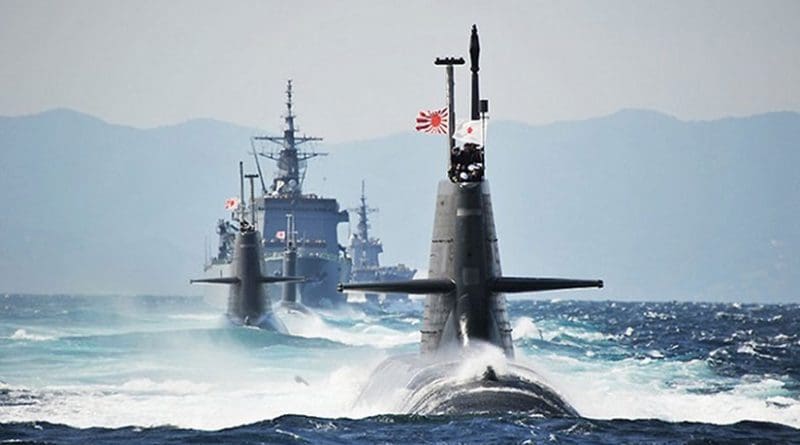Japan’s Disappointing Entrée Into The Global Arms Market – Analysis
By RSIS
Japan’s failure to win the Australian submarine contract highlights the challenges of entering the global arms market. Japan may secure export sales in the future, but it will likely have to start small and be realistic.
By Richard A. Bitzinger*
In the baseball film, “The Natural,” there is a scene in which the hero, an aging rookie ballplayer by the name of Roy Hobbs, gets his first at-bat in a major league game; to his surprise, he quickly takes two strikes, at which point a sportscaster mockingly pronounces, “welcome to the big leagues, Mr. Hobbs”.
Japan’s defence industry got a similar humbling a few weeks ago when Australia announced it would sign a US$38.7 billion deal with France for 12 new submarines. Many assumed that the sale was a lock for Tokyo. Japan had a good product – the 4000-ton Sōryū-class sub – and Prime Minister Abe’s close relationship with former Australian premier Tony Abbot appeared to seal the deal. Instead, Japan learned a valuable if bitter lesson that overseas arms sales are, in most cases, anything but certain.
The Pressure to Export Arms
Defence industries believe in arms exports in the same way that a drowning man believes in life preservers. Only a very few of the world’s largest arms-producing countries – basically, the United States, Russia, and China – have large enough domestic defence markets so as not to depend on overseas sales for their survival. Even then, they compete aggressively for exports, which can be worth billions of dollars and protect thousands of jobs.
For most other arms producers, however, overseas arms sales are a matter of life or death. They have to export the bulk of their defence industrial output just to keep their factories open and their production lines hot. This includes not only newcomers like Brazil, Israel, Bulgaria, and South Africa, but also leading arms manufacturing states such as Britain and France.
For decades, Japan resisted arms sales as a matter of ethics born out of its postwar pacifism. Japan’s arms export ban goes back to the 1960s, which Tokyo decided not to sell weapons to communist or UN-embargoed nations, or to countries “involved in or likely to be involved in international conflicts.” This ban was later expanded to include any arms exports, in keeping with “Japan’s position as a peace-loving nation.”
Simple economics, however, has pressured Japan to reverse course and pursue arms exports. It defence industry is in its biggest slump since the country began to rearm in the 1950s. Military expenditures have been declining since the turn of the century, and, as a result, the SDF has been slashing procurement. The impact on the local arms industry has been nothing short of disastrous. In recent years, over 50 Japanese defence firms or subcontractors have withdrawn from doing armaments work, while another 13 firms have gone bankrupt.
Arms Exports: Easier Said than Done
Obviously, Japan’s defence industry, like those in other countries, would love to ride the arms exports gravy train. At the same time, Tokyo is learning – as the Australian submarine debacle made plain – that there are no guarantees when it comes to overseas arms sales. It would be useful, therefore, for Japan – as well as other wannabe arms exporters – to be familiar with the basic realities of the global arms trade:
Having a great product is not enough. The fact is, the global arms market is awash with great pieces of military kit, all being flogged by extremely motivated sellers. Japan must going up against long-standing arms exporters like the United States, Israel, or (in the case of submarines) France, all of whom offer similar weapons systems of equal or greater capabilities. In other words, it’s a buyer’s market, and the buyers know it.
Cost is sometimes the least important criteria. Price is important, but non-economic factors frequently come into play. Countries like the US, Russia, and Israel can often offer battle-tested equipment with proven reliability. They also have more experience when it comes to after-sales support, such as spare parts and maintenance, as well as industrial incentives such as offsets.
In addition, countries will often buy weapons from a certain supplier because it bolsters alliances or strengthens bilateral relationships. (At the same time, if you buy cheap, you get cheap; this is why China mainly sells only to poorer countries, like Pakistan or in sub-Saharan Africa, which cannot afford anything else.)
Nothing succeeds like success. Japanese military systems are contending in an intensely competitive global arms market. The barriers to entry into this market are very high, and already established arms suppliers have the inside track when it comes to most international arms sales. This is why the United States and Russia have for decades accounted for more than half the global arms market, while the four largest West European arms exporters – France, Germany, Italy and the United Kingdom – together typically make up around another 20 percent.
The Way Ahead
All is not gloom and doom for Japan’s would-be arms exporters. Japan certainly has some export-worthy military equipment, such as its P-1 maritime patrol aircraft or C-2 cargo plane; Tokyo has particularly high hopes for its unique US-2 flying boat (which it is, in fact, trying to interest India in buying).
Nevertheless, Tokyo has to be realistic about its prospects for overseas arms sales: even if they do materialise, they will still be pretty thin gruel for Japan’s defence industry. Overall, the arms industry faces long-term challenges, both structural and financial, and a handful of arms exports are unlikely to fix these.
*Richard A. Bitzinger is a Senior Fellow and Coordinator of the Military Transformations Programme at the S. Rajaratnam School of International Studies (RSIS), Nanyang Technological University, Singapore. This Commentary is based on a recent article by the author that appeared in Asia Times.

